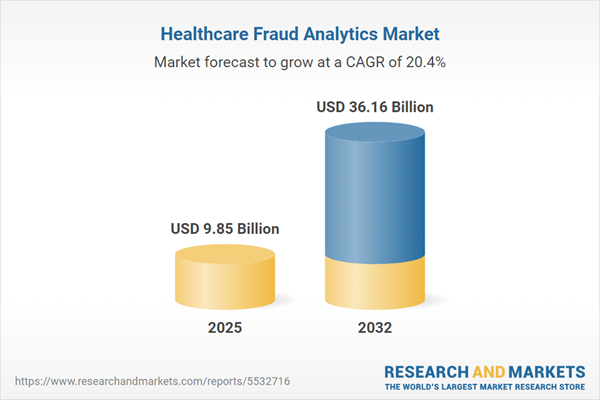Speak directly to the analyst to clarify any post sales queries you may have.
Healthcare fraud analytics is essential for organizations intent on safeguarding operational integrity while navigating increased regulatory complexity in digital health. As compliance challenges intensify and technology advances, fraud analytics provides decision-makers with actionable intelligence and a resilient foundation for proactive risk management.
Market Snapshot: Healthcare Fraud Analytics Market Growth
The healthcare fraud analytics market reached a value of USD 8.18 billion in 2024, with expectations to rise to USD 9.85 billion by 2025 and a notable CAGR of 20.41%, positioning the sector to achieve USD 36.16 billion by 2032.
Expansion is driven by growing investments in cloud-based analytics and AI-powered fraud detection platforms. Organizations are utilizing advanced analytics to reinforce fraud prevention measures, comply with evolving standards, and update their technology infrastructure. Emphasis on digital health transformation is reshaping how healthcare enterprises address compliance and risk across global ecosystems.Scope & Segmentation: Healthcare Fraud Analytics Market Coverage
- Component Types: Consulting services, managed services, implementation support, and integrated software combine to provide a robust analytics infrastructure, enabling real-time insights and advanced data analysis.
- Deployment Modes: Cloud, hybrid, and on-premise models offer organizations the flexibility to address diverse security, scalability, and data governance priorities, facilitating the adoption of the most suitable deployment strategies.
- End Users: Government agencies, insurers, pharmaceutical firms, healthcare delivery organizations, and third-party administrators leverage fraud analytics for focused risk assessment, enhanced compliance, and improved transparency.
- Analytics Types: Solutions support compliance oversight, fraud detection, investigative processes, recovery management, and risk evaluation across both clinical and payment domains.
- Application Areas: Includes claims assessment, billing audit, provider and network analysis, and patient activity monitoring, each reinforcing accountability and supporting effective fraud prevention.
- Geographic Regions: The Americas, Europe, Asia-Pacific, and Middle East & Africa are characterized by unique adoption trends, shaped by regulatory expectations, local compliance practices, and a varying pace of analytics innovation.
- Leading Providers: Companies such as Fair Isaac Corporation, SAS Institute Inc., Optum, Cotiviti, IBM, LexisNexis Risk Solutions, Experian Information Solutions, SAP SE, Change Healthcare, and DXC Technology provide industry-focused analytics, consultancy, and compliance solutions.
Key Takeaways for Senior Decision-Makers
- AI-driven fraud analytics platforms enable organizations to anticipate and respond to evolving threat patterns, facilitating timely and accurate compliance decisions across healthcare operations.
- Automation introduces efficiency in claims management and health record integration, reducing manual processing errors and supporting consistent compliance monitoring.
- Flexibility in deployment—through cloud or hybrid solutions—allows adaptation to new technology standards and distinct regulatory frameworks in various markets.
- Collaboration among payers, providers, technology vendors, and regulatory authorities is critical for building system-wide trust and operational resilience.
- Modular analytics architectures allow organizations to expand capabilities incrementally, aligning technology growth with emerging strategic goals and compliance mandates.
- Built-in governance features support consistent processes and adherence to regional and global legal requirements, aiding multinational operations in maintaining oversight control.
Assessing Tariff Impact: Navigating Cost and Supply Chain Shifts
Adoption of new healthcare fraud analytics platforms may be influenced by uncertainty in digital equipment trade tariffs and variable procurement costs. Organizations can mitigate these potential impacts through cloud-native and subscription-based models, reducing up-front investments while ensuring scalability and reliable infrastructure. Leveraging modular technology, cultivating partnerships with established analytics vendors, and engaging in cross-industry alliances all contribute to effective risk management. Strategic sourcing and agile procurement further support operational stability during periods of supply chain volatility.
Methodology & Data Sources
The insights in this report are informed by extensive secondary research, expert interviews with healthcare analytics specialists, and in-depth analysis of real-world use cases. An advisory board reviews and validates each finding, ensuring alignment with digital transformation objectives and compliance standards in healthcare.
Why This Report Matters
- Helps senior leaders optimize risk management and technology investment planning as operational and compliance priorities evolve within the healthcare fraud analytics sector.
- Enables evidence-driven procurement, allowing organizations to match analytics capabilities with domestic and international regulatory requirements efficiently.
- Offers vendor selection guidance, promoting adaptability to new and emerging threats in diverse healthcare environments.
Conclusion
This analysis provides executives with key intelligence to strengthen fraud prevention, modernize oversight, and improve resilience as digital health and compliance demands advance.
Additional Product Information:
- Purchase of this report includes 1 year online access with quarterly updates.
- This report can be updated on request. Please contact our Customer Experience team using the Ask a Question widget on our website.
Table of Contents
3. Executive Summary
4. Market Overview
7. Cumulative Impact of Artificial Intelligence 2025
Companies Mentioned
The companies profiled in this Healthcare Fraud Analytics market report include:- Fair Isaac Corporation
- SAS Institute Inc.
- Optum, Inc.
- Cotiviti, LLC
- International Business Machines Corporation
- LexisNexis Risk Solutions Inc.
- Experian Information Solutions, Inc.
- SAP SE
- Change Healthcare LLC
- DXC Technology Company
Table Information
| Report Attribute | Details |
|---|---|
| No. of Pages | 181 |
| Published | November 2025 |
| Forecast Period | 2025 - 2032 |
| Estimated Market Value ( USD | $ 9.85 Billion |
| Forecasted Market Value ( USD | $ 36.16 Billion |
| Compound Annual Growth Rate | 20.4% |
| Regions Covered | Global |
| No. of Companies Mentioned | 11 |









